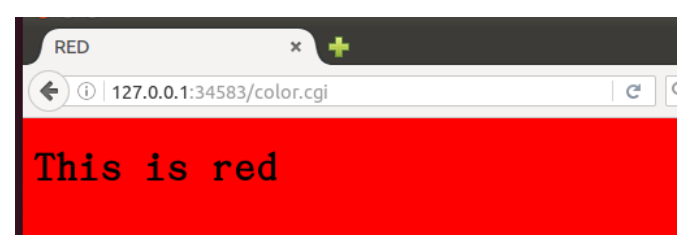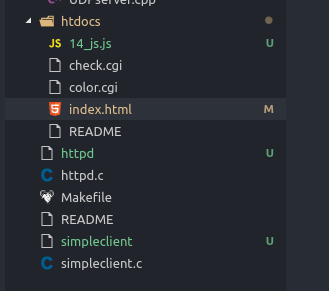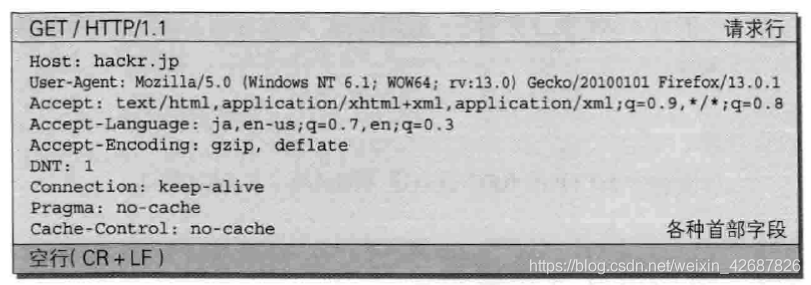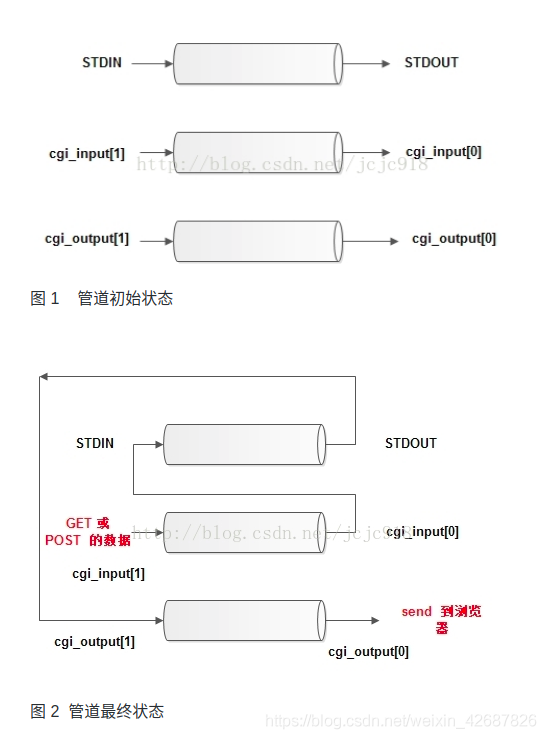Project transfer, with Chinese translation: https://github.com/nengm/Tinyhttpd
In embedded systems, the most commonly used HTTP servers are boa and goahead, but these two codes are relatively large, while Tinyhttpd only has a few hundred lines, which is more helpful for us to learn.
1. Compile and run
Directly after make, so if html has execution permission, remove it first. chmod 600 index.html color.cgi and date.cgi must have execution permission. It still doesn't work after this. You need to change the first line of the cgi script to "#!/usr/bin/perl" and it will run.

After running, the port of the http server is 41163
The effect is roughly like this. The screenshot is not from my machine.

However, I changed the html to this. Originally, I put the js in another file separately. I don’t know why, but there was no response. In the end, I could only write the js functions together in the html.
<html>
<head>
<title>table</title>
<meta charset="UTF-8">
<!--这是描述 js中的函数来之哪个js文件-->
<script type="text/javascript">
function my_button(arg)
{
if(arg == 1)//登录 admin 123456
{
//获取网页上输入框的用户名密码
var usr = document.getElementById("usr").value;//重点
var pwd = document.getElementById("pwd").value;
if(usr=="admin" && pwd=="123456")
{
window.location.href="http://www.baidu.com";
}
else
{
alert("用户名或密码错误请重新输入");
//清空用户名密码的输入框
document.getElementById("usr").value="";
document.getElementById("pwd").value="";
}
}
else if(arg == 0)//取消
{
//清空用户名密码的输入框
document.getElementById("usr").value="";
document.getElementById("pwd").value="";
}
}
</script>
</head>
<body>
<!--id是唯一 标记一个个标签-->
用户名:<input type="text" id="usr">
<br>
密码:<input type="password" id="pwd">
<br>
<input type="button" value="登录" onclick="my_button(1);">
<input type="button" value="取消" onclick="my_button(0);">
</body>
</html>The effect is like this, from my local machine:

2. Code analysis
Reading this program requires the basics of UNIX programming, including socket-related APIs, multi-threading (although not used under Linux), multi-process and inter-process communication, and basic knowledge of HTTP.
First, download the source code locally. We can see that the project code mainly includes the main program httpd.c, a client simpleclient.c, an interface and some cgi scripts under htdocs, and others are some compilation-related files and project structure. As shown below:

There are two comments at the beginning of the main file. One is the program comment, which includes a brief description of the program, author, time, (good guy, 1999, ancient god), and address. This is also an international practice. When coding, Also have good habits.
Under normal circumstances, at the code level, the main function is the starting point for program running, so when we read the source code, we also start with the main function. We can see at the beginning of the main function that the author has created some local variables to save the parameters and parameters for subsequent creation of network connections. A client variable. In the subsequent code, we can see the role of these parameters more intuitively.
Start from the main function
int main(void)
{
//在Ubuntu 16.04下运行,进行了修改
int server_sock = -1;//服务器端fd
u_short port = 0;//端口号,传0则随机绑定端口
int client_sock = -1;//客户端fd
struct sockaddr_in client_name;
socklen_t client_name_len = sizeof(client_name);
pthread_t newthread;
server_sock = startup(&port);//返回一个服务器端socket
printf("httpd running on port %d\n", port);
//不断循环接收连接请求
while (1)
{
client_sock = accept(server_sock,
(struct sockaddr *)&client_name,
&client_name_len);//阻塞等待连接
if (client_sock == -1)
error_die("accept");
//本来是线程版本,按照Linux注释修改,现在同一时间只能处理一个请求
//应该是1999年Linux还没有线程的功能吧。。。
//accept_request(&client_sock);//http请求的具体处理函数
if (pthread_create(&newthread , NULL, accept_request, (void *)&client_sock) != 0)
perror("pthread_create");
}
//关闭服务器端socket
close(server_sock);
return(0);
}You can see that the whole process is very simple and the comments are clearly written.
用startup(&port);函数初始化后,处理的逻辑由accept_request(&client_sock);实现。
初始化函数startup(&port)
这个函数开启一个socket来监听特定端口的网络请求,输入参数为0时则动态生成一个端口号,否则用输入的参数做端口号。
int startup(u_short *port)
{
int httpd = 0;
int on = 1;
struct sockaddr_in name;
httpd = socket(PF_INET, SOCK_STREAM, 0);//创建socket
if (httpd == -1)//创建失败处理
error_die("socket");
memset(&name, 0, sizeof(name));//清空name内容
//设置name的参数,分别代表采用IPv4、端口的主机字节序转网络字节序、地址
name.sin_family = AF_INET;
name.sin_port = htons(*port);
name.sin_addr.s_addr = htonl(INADDR_ANY);
//设置端口复用
if ((setsockopt(httpd, SOL_SOCKET, SO_REUSEADDR, &on, sizeof(on))) < 0)
{
error_die("setsockopt failed");
}
//绑定socket和地址
if (bind(httpd, (struct sockaddr *)&name, sizeof(name)) < 0)
error_die("bind");
//如果传入参数为0,则动态分配端口,获取端口号并传出
if (*port == 0) /* if dynamically allocating a port */
{
socklen_t namelen = sizeof(name);
if (getsockname(httpd, (struct sockaddr *)&name, &namelen) == -1)
error_die("getsockname");
*port = ntohs(name.sin_port);
}
//设置同时监听的上限数为5
if (listen(httpd, 5) < 0)
error_die("listen");
return(httpd);
}初始化函数也很基础,过一遍APUE基本都一样,唯一不同就是这个端口分配的骚操作,注意一下就行。接下来就是重头戏accept_request(&client_sock);,我这个计网0基础的不得不补习了半天HTTP才勉强整明白。
请求处理accept_request(&client_sock)
由于该函数较长,分为多个部分分析。
请求行的处理
函数一开始对socket发送过来的数据按照HTTP协议进行了处理,HTTP请求格式如下:

先对第一行请求行进行处理。
void *accept_request(void* tclient)
{
int client = *(int *)tclient;
char buf[1024];
size_t numchars;
char method[255];
char url[255];
char path[512];
size_t i, j;
struct stat st;
int cgi = 0; /* becomes true if server decides this is a CGI
* program */
char *query_string = NULL;
numchars = get_line(client, buf, sizeof(buf));//读取一行http请求到buf中
// 根据HTTP协议,第一行为请求行包括:
// 方法+URI+HTTP版本 例如:GET / HTTP/1.1
// 即目前的buf中包括以上三部分
i = 0; j = 0;
// ①先获取方法到method中
// isspace判断字符是否为空字符,为空则返回true
while (!ISspace(buf[i]) && (i < sizeof(method) - 1))
{
method[i] = buf[i];
i++;j++;
}
method[i] = '\0';
// 由于httpd比较简单,仅支持GET方法或POST方法
// strcasecmp忽略大小写比较字符串是否相等,如果都不等,则返回错误信息给客户端
if (strcasecmp(method, "GET") && strcasecmp(method, "POST"))
{
unimplemented(client);
return NULL;
}
// 如果是POST方法则将cgi置1
if (strcasecmp(method, "POST") == 0)
cgi = 1;
// ②获取url到变量url中
i = 0;
while (ISspace(buf[j]) && (j < numchars))
j++;
while (!ISspace(buf[j]) && (i < sizeof(url) - 1) && (j < numchars))
{
url[i] = buf[j];
i++; j++;
}
url[i] = '\0';
// 如果是GET方法,可能含有查询请求,将url问号后的内容保存到query_string中
if (strcasecmp(method, "GET") == 0)
{
query_string = url;
// 一直把url中问号之前内容遍历
while ((*query_string != '?') && (*query_string != '\0'))
query_string++;
if (*query_string == '?')
{
// 如果有问号则表示需要执行cgi文件,将其变量置1
cgi = 1;
// 将url分割成两段,现在url表示问号前的部分,query_string表示问号后的部分
*query_string = '\0';
query_string++;
}
}此时分割出了请求方法和URL,为了避免文章过长,其中用到的int get_line(int sock, char *buf, int size)等函数可以下载我注释的完整文件来看。
本地处理
// 将url添加到htdocs后并赋值给path
sprintf(path, "htdocs%s", url);
// 如果是以/结尾则把主页加在后面
if (path[strlen(path) - 1] == '/')
strcat(path, "index.html");
// 在系统中查看path路径文件是否存在
if (stat(path, &st) == -1) {
// 如果不存在则将本次HTTP请求的后续内容全部丢弃
while ((numchars > 0) && strcmp("\n", buf)) /* read & discard headers */
numchars = get_line(client, buf, sizeof(buf));
not_found(client);
}
else
{
// 如果存在该文件,判断其是否为路径名,是则在后面加上/index.html
if ((st.st_mode & S_IFMT) == S_IFDIR)
strcat(path, "/index.html");
// 只要该文件具有可执行权限,则将cgi置1
if ((st.st_mode & S_IXUSR) ||
(st.st_mode & S_IXGRP) ||
(st.st_mode & S_IXOTH) )
cgi = 1;
// 根据cgi的值执行不同的处理函数
if (!cgi)
serve_file(client, path);
else
execute_cgi(client, path, method, query_string);
}
close(client);其中stat函数原型为:int stat(const char *file_name, struct stat *buf ),它通过文件名filename获取文件信息,并保存在buf所指的结构体stat中。
如果没有执行cgi请求,则执行serve_file
void serve_file(int client, const char *filename)
{
FILE *resource = NULL;
int numchars = 1;
char buf[1024];
// 保证能进入下面的while
buf[0] = 'A'; buf[1] = '\0';
// 将本次Http请求后续内容丢弃
while ((numchars > 0) && strcmp("\n", buf)) /* read & discard headers */
numchars = get_line(client, buf, sizeof(buf));
// 打开文件
resource = fopen(filename, "r");
// 文件不存在则返回一个404状态码
if (resource == NULL)
not_found(client);
else
{
// 返回200成功状态码
headers(client, filename);
// 将文件内容发送到client
cat(client, resource);
}
fclose(resource);
}如果cgi被置1,则执行execute_cgi
void execute_cgi(int client, const char *path,
const char *method, const char *query_string)
{
char buf[1024];
int cgi_output[2];
int cgi_input[2];
pid_t pid;
int status;
int i;
char c;
int numchars = 1;
int content_length = -1;
// 保证能进入while循环
buf[0] = 'A'; buf[1] = '\0';
// 如果是GET,丢弃本次HTTP请求后续内容
if (strcasecmp(method, "GET") == 0)
while ((numchars > 0) && strcmp("\n", buf)) /* read & discard headers */
numchars = get_line(client, buf, sizeof(buf));
else if (strcasecmp(method, "POST") == 0) /*POST*/
{
numchars = get_line(client, buf, sizeof(buf));
//这个循环的目的是读出指示 body 长度大小的参数,并记录 body 的长度大小。其余的 header 里面的参数一律忽略
//注意这里只读完 header 的内容,body 的内容没有读
while ((numchars > 0) && strcmp("\n", buf))
{
buf[15] = '\0';
if (strcasecmp(buf, "Content-Length:") == 0)
content_length = atoi(&(buf[16]));
numchars = get_line(client, buf, sizeof(buf));
}
// 如果header没有表示body的长度则返回错误
if (content_length == -1) {
bad_request(client);
return;
}
}
else/*HEAD or other*/
{
}
sprintf(buf, "HTTP/1.0 200 OK\r\n");
send(client, buf, strlen(buf), 0);
// 创建两个管道
if (pipe(cgi_output) < 0) {
cannot_execute(client);
return;
}
if (pipe(cgi_input) < 0) {
cannot_execute(client);
return;
}
// 创建子进程
if ( (pid = fork()) < 0 ) {
cannot_execute(client);
return;
}
// 子进程用于处理CGI脚本
if (pid == 0) /* child: CGI script */
{
char meth_env[255];
char query_env[255];
char length_env[255];
//将子进程的输出由标准输出重定向到 cgi_output 的管道写端上
dup2(cgi_output[1], STDOUT);
//将子进程的输入由标准输入重定向到 cgi_input 的管道读端上
dup2(cgi_input[0], STDIN);
// 关闭cgi_ouput的读和cgi_input的写
close(cgi_output[0]);
close(cgi_input[1]);
//构造一个环境变量
sprintf(meth_env, "REQUEST_METHOD=%s", method);
putenv(meth_env);//将这个环境变量加进子进程的运行环境中
//根据http 请求的不同方法,构造并存储不同的环境变量
if (strcasecmp(method, "GET") == 0) {
sprintf(query_env, "QUERY_STRING=%s", query_string);
putenv(query_env);
}
else { /* POST */
sprintf(length_env, "CONTENT_LENGTH=%d", content_length);
putenv(length_env);
}
// 执行path处的脚本
execl(path, path, NULL);
exit(0);
} else { /* parent */
// 关闭cgi_ouput的写和cgi_input的读
close(cgi_output[1]);
close(cgi_input[0]);
//如果是 POST 方法的话就继续读 body 的内容,并写到 cgi_input 管道里让子进程去读
if (strcasecmp(method, "POST") == 0)
for (i = 0; i < content_length; i++) {
recv(client, &c, 1, 0);
write(cgi_input[1], &c, 1);
}
//然后从 cgi_output 管道中读子进程的输出,并发送到客户端去
while (read(cgi_output[0], &c, 1) > 0)
send(client, &c, 1, 0);
//关闭管道
close(cgi_output[0]);
close(cgi_input[1]);
//等待子进程的退出
waitpid(pid, &status, 0);
}
}这里创建了一个子进程用来执行cgi程序,而父进程用于和socket通信,那么子进程执行的结果就需要发送给父进程,再由父进程发给socket,这里使用的是pipe管道,过程如下图。注意:这里的cgi_input和cgi_output是两个管道的名字,其in和out是对于子进程来说的,即cgi_input管道用于向子进程写入数据、cgi_output用于由子进程向父进程发出数据:

那么数据会先由父进程从socket读入,再发送到cgi_input的写端,子进程读入后给cgi处理,然后通过cgi_output发给父进程,父进程再发给socket。